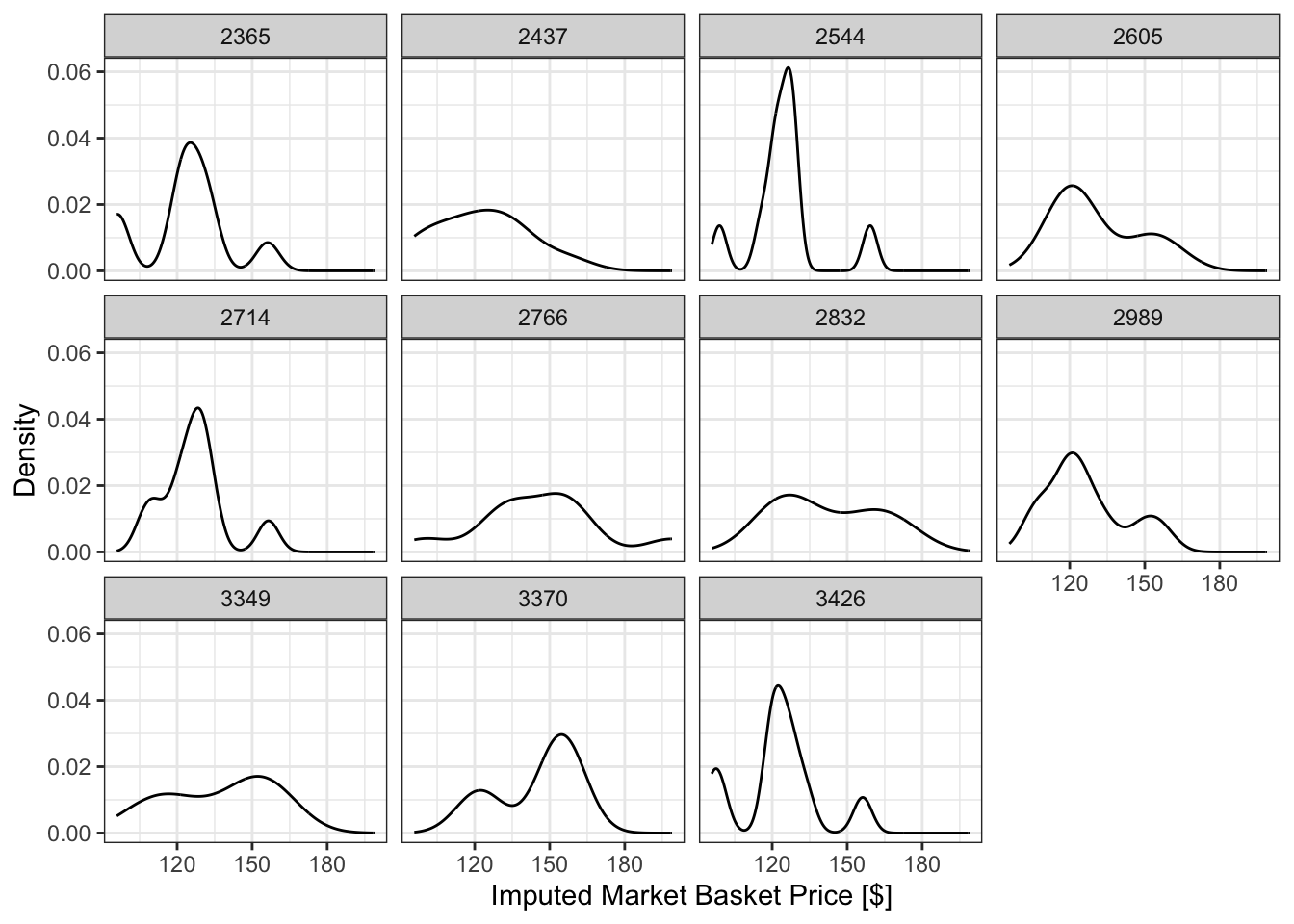Emerging mobile device data, however, could reveal the typical home locations for people who are observed in the space of a particular store. Macfarlane et al. (2022) present a method for estimating destination choice models from such data, which we repeat in this study. We provided a set of geometric polygons for the grocery stores of interest to StreetLight Data, Inc., a commercial location-based services aggregator and reseller. StreetLight Data in turn provided data on the number of mobile devices observed in each polygon grouped by the inferred residence block group of those devices during summer 2022. We then created a simulated destination choice estimation dataset for each community resource by sampling 10,000 block group - grocery store “trips” from the StreetLight dataset. This created a “chosen” alternative; we then sampled ten additional stores from the same community at random (each simulated trip was paired with a different sampled store) to serve as the non-chosen alternatives. Random sampling of alternatives is a common practice that results in unbiased estimates, though the standard errors of the estimates might be larger than could be obtained through a more carefully designed sampling scheme (Train, 2009).
Barnes, M. (2021). Resiliency of Utah’s Road Network: A Logit-Based Approach [{{MS Thesis}}]. Brigham Young University.
Ben-Akiva, M., & Lerman, S. R. (1985).
Discrete Choice Analysis: Theory and Applications to Travel Demand.
MIT Press.
https://www.jstor.org/stable/1391567
Conway, M. W., Byrd, A., & Eggermond, M. van. (2018). Accounting for uncertainty and variation in accessibility metrics for public transport sketch planning.
Journal of Transport and Land Use,
11(1).
https://doi.org/10.5198/jtlu.2018.1074
Conway, M. W., Byrd, A., & van der Linden, M. (2017). Evidence-
Based Transit and
Land Use Sketch Planning Using Interactive Accessibility Methods on
Combined Schedule and
Headway-Based Networks.
Transportation Research Record,
2653(1), 45–53.
https://doi.org/10.3141/2653-06
Conway, M. W., & Stewart, A. F. (2019). Getting
Charlie off the
MTA: A multiobjective optimization method to account for cost constraints in public transit accessibility metrics.
International Journal of Geographical Information Science,
33(9), 1759–1787.
https://doi.org/10.1080/13658816.2019.1605075
FNS. (2021). Thrifty Food Plan. Food and Nutrition Service, United States Department of Agriculture.
Geurs, K., Zondag, B., de Jong, G., & de Bok, M. (2010). Accessibility appraisal of land-use/transport policy strategies:
More than just adding up travel-time savings.
Transportation Research Part D: Transport and Environment,
15(7), 382–393.
https://doi.org/10.1016/j.trd.2010.04.006
Glanz, K., Sallis, J. F., Saelens, B. E., & Frank, L. D. (2007). Nutrition
Environment Measures Survey in
Stores (
NEMS-S):
Development and
Evaluation.
American Journal of Preventive Medicine,
32(4), 282–289.
https://doi.org/10.1016/j.amepre.2006.12.019
Hedrick, V. E., Farris, A. R., Houghtaling, B., Mann, G., & Misyak, S. A. (2022). Validity of a
Market Basket Assessment Tool for
Use in
Supplemental Nutrition Assistance Program Education Healthy Retail Initiatives.
Journal of Nutrition Education and Behavior,
54(8), 776–783.
https://doi.org/10.1016/j.jneb.2022.02.018
Kaczynski, A. T., Schipperijn, J., Hipp, J. A., Besenyi, G. M., Wilhelm Stanis, S. A., Hughey, S. M., & Wilcox, S. (2016).
ParkIndex:
Development of a standardized metric of park access for research and planning.
Preventive Medicine,
87, 110–114.
https://doi.org/10.1016/j.ypmed.2016.02.012
Logan, T., Williams, T., Nisbet, A., Liberman, K., Zuo, C., & Guikema, S. (2019). Evaluating urban accessibility: Leveraging open-source data and analytics to overcome existing limitations.
Environment and Planning B: Urban Analytics and City Science,
46(5), 897–913.
https://doi.org/10.1177/2399808317736528
Lunsford, J., Brunt, A., Foote, J., Rhee, Y., Strand, M., & Segall, M. (2021). Analysis of
Availability,
Quality, and
Price of
Food Options in
Denver,
CO Grocery Stores.
Journal of Hunger & Environmental Nutrition,
16(3), 297–303.
https://doi.org/10.1080/19320248.2020.1741482
Macfarlane, G., Voulgaris, C. T., & Tapia, T. (2022). City parks and slow streets:
A utility-based access and equity analysis.
Journal of Transport and Land Use,
15(1), 587–612.
https://doi.org/10.5198/jtlu.2022.2009
McFadden, D. (1974). Conditional logit analysis of qualitative choice behavior. In P. Zarembka (Ed.), Frontiers in Econometrics (pp. 105–142). Academic Press.
Pereira, R. H. M., Saraiva, M., Herszenhut, D., Braga, C. K. V., & Conway, M. W. (2021). R5r:
Rapid Realistic Routing on
Multimodal Transport Networks with
R5 in
R.
Findings.
https://doi.org/10.32866/001c.21262
Recker, W. W., & Kostyniuk, L. P. (1978). Factors influencing destination choice for the urban grocery shopping trip.
Transportation,
7(1), 19–33.
https://doi.org/10.1007/BF00148369
Train, K. E. (2009). Discrete Choice Methods with Simulation (2nd edition). Cambridge University Press.
van Buuren, S., & Groothuis-Oudshoorn, K. (2011).
mice: Multivariate imputation by chained equations in r.
Journal of Statistical Software,
45(3), 1–67.
https://doi.org/10.18637/jss.v045.i03
